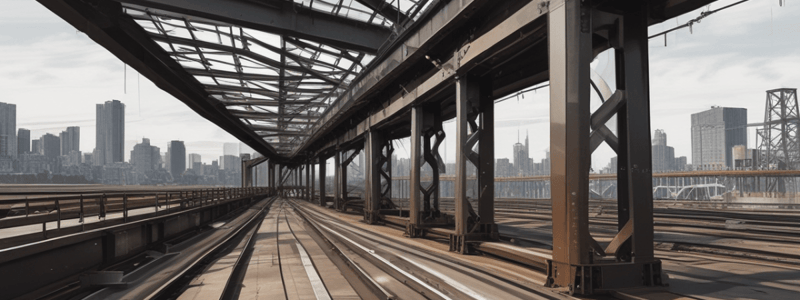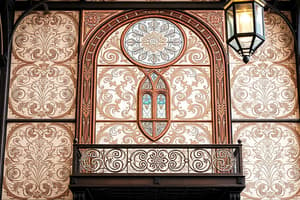Podcast
Questions and Answers
Why do beams used to support concrete building and bridge floors often require lateral support?
Why do beams used to support concrete building and bridge floors often require lateral support?
- To prevent buckling of the compression flange (correct)
- To reduce the beam's self-weight
- To resist shear forces
- To increase the beam's moment of inertia
What is the primary reason why the compression flange of a beam may buckle?
What is the primary reason why the compression flange of a beam may buckle?
- Due to the type of material used
- Due to the lack of lateral support (correct)
- Due to the weight of the beam itself
- Due to the type of loading conditions
What happens when the compression flange of a beam is long enough and slender enough?
What happens when the compression flange of a beam is long enough and slender enough?
- It remains unaffected by its length and slenderness
- It becomes weaker and more prone to buckling (correct)
- It always buckles, regardless of lateral support
- It becomes stronger and more resistant to buckling
What is the effect of residual stresses in a beam section on its buckling behavior?
What is the effect of residual stresses in a beam section on its buckling behavior?
What is the primary purpose of lateral support in a beam?
What is the primary purpose of lateral support in a beam?
How does the tension in the other flange of a beam affect its buckling behavior?
How does the tension in the other flange of a beam affect its buckling behavior?
What happens as the bending moment in a beam is increased?
What happens as the bending moment in a beam is increased?
What is a key factor affecting the amount of stress that causes buckling in the compression flange of a beam?
What is a key factor affecting the amount of stress that causes buckling in the compression flange of a beam?
What is the orientation of the beams in their upright positions?
What is the orientation of the beams in their upright positions?
Where can the proper plastic modulus about the y-axis be found for a beam turned on its side?
Where can the proper plastic modulus about the y-axis be found for a beam turned on its side?
What percentage of strength does a W shape turned on its side retain compared to its upright position when subjected to gravity loads?
What percentage of strength does a W shape turned on its side retain compared to its upright position when subjected to gravity loads?
What type of loads are considered when analyzing the strength of a beam turned on its side?
What type of loads are considered when analyzing the strength of a beam turned on its side?
What is the purpose of finding the proper plastic modulus about the y-axis for a beam turned on its side?
What is the purpose of finding the proper plastic modulus about the y-axis for a beam turned on its side?
What is the effect of turning a W shape on its side on its strength?
What is the effect of turning a W shape on its side on its strength?
What is the primary consideration when designing beams for moments?
What is the primary consideration when designing beams for moments?
Where can the tables giving dimensions and properties of shapes be found?
Where can the tables giving dimensions and properties of shapes be found?
What does the letter E represent in the classification of filler metal electrodes for shielded arc welding?
What does the letter E represent in the classification of filler metal electrodes for shielded arc welding?
What is the minimum tensile strength of a weld indicated by the digits 70 in the classification E70XX?
What is the minimum tensile strength of a weld indicated by the digits 70 in the classification E70XX?
For what range of Fy values are E70 electrodes typically used?
For what range of Fy values are E70 electrodes typically used?
What is the minimum length of a fillet weld in relation to the nominal leg size of the weld?
What is the minimum length of a fillet weld in relation to the nominal leg size of the weld?
What is the maximum size of a fillet weld along edges of material less than 1/4 in thick?
What is the maximum size of a fillet weld along edges of material less than 1/4 in thick?
Why is it desirable to keep the weld back at least 1/16 in from the edge of a plate with a thickness of 1/4 in or more?
Why is it desirable to keep the weld back at least 1/16 in from the edge of a plate with a thickness of 1/4 in or more?
What happens if the length of a fillet weld is less than four times the nominal leg size of the weld?
What happens if the length of a fillet weld is less than four times the nominal leg size of the weld?
Where can provisions applying to welding be found?
Where can provisions applying to welding be found?
What is the design strength of the connection shown in Figure, if the plates consist of A572 Grade 50 steel and E70 electrodes were used, and the 7/16-in fillet welds were made by the SMAW process?
What is the design strength of the connection shown in Figure, if the plates consist of A572 Grade 50 steel and E70 electrodes were used, and the 7/16-in fillet welds were made by the SMAW process?
What is the minimum required strength of the electrodes to be used in the SMAW process for welding A572 Grade 50 steel?
What is the minimum required strength of the electrodes to be used in the SMAW process for welding A572 Grade 50 steel?
What is the purpose of using E70 electrodes in the SMAW process?
What is the purpose of using E70 electrodes in the SMAW process?
What is the minimum required thickness of the fillet welds to be used in the SMAW process for welding A572 Grade 50 steel?
What is the minimum required thickness of the fillet welds to be used in the SMAW process for welding A572 Grade 50 steel?
What is the design strength of the 5/16-in E70 fillet welds shown in the Figure?
What is the design strength of the 5/16-in E70 fillet welds shown in the Figure?
What is the purpose of using longitudinal and transverse fillet welds in the design of connections?
What is the purpose of using longitudinal and transverse fillet welds in the design of connections?
What is the LRFD design strength of the connection shown in Figure, if the plates consist of A572 Grade 50 steel and E70 electrodes were used, and the 5/16-in fillet welds were made by the SMAW process?
What is the LRFD design strength of the connection shown in Figure, if the plates consist of A572 Grade 50 steel and E70 electrodes were used, and the 5/16-in fillet welds were made by the SMAW process?
What is the total LRFD design strength of the 5/16-in E70 fillet welds shown in the Figure?
What is the total LRFD design strength of the 5/16-in E70 fillet welds shown in the Figure?
What is the primary purpose of welding in structural steel design?
What is the primary purpose of welding in structural steel design?
What is the term for the type of beam section that is being discussed in the content?
What is the term for the type of beam section that is being discussed in the content?
What is the significance of the equation ϭϯ͘ϭϱ ƐŚŽǁƐ Ă ŚĂŶŐĞƌͲƚLJƉĞ?
What is the significance of the equation ϭϯ͘ϭϱ ƐŚŽǁƐ Ă ŚĂŶŐĞƌͲƚLJƉĞ?
What is the main topic of the lecture in which the content is presented?
What is the main topic of the lecture in which the content is presented?
What is the name of the department that is presenting the lecture?
What is the name of the department that is presenting the lecture?
What is the process by which metallic parts are connected in welding?
What is the process by which metallic parts are connected in welding?
What is the term for the type of failure that is being discussed in the content?
What is the term for the type of failure that is being discussed in the content?
What is the purpose of the equations and formulas presented in the content?
What is the purpose of the equations and formulas presented in the content?
Flashcards are hidden until you start studying
Study Notes
Design of Beams for Moments
- A beam's plastic modulus values in the table are given for beams in their upright positions.
- If a beam is turned on its side, the proper plastic modulus about the y-axis can be found in Table 3-4 of the Manual or in the tables giving dimensions and properties of shapes in Part 1 of the AISC Manual.
- A W shape turned on its side may be only 10 to 30 percent as strong as one in the upright position when subjected to gravity loads.
Lateral Support of Beams
- Beams used to support concrete building and bridge floors are often incorporated in these concrete floors, and will fall into Zone 1.
- If the compression flange of a beam is without lateral support for some distance, it will have a stress situation similar to that existing in columns.
- The compression flange of a beam may buckle unless lateral support is provided, and the amount of stress that will cause buckling is affected by many factors.
Welded Connections
- Welding is a process by which metallic parts are connected by heating their surfaces to a plastic or fluid state and allowing the parts to flow together and join (with or without the addition of other molten metal).
- The filler metal electrodes for shielded arc welding are listed as E60XX, E70XX, etc., and the first set of digits indicates the minimum tensile strength of the weld in ksi.
- E70 electrodes are used for steels with Fy values from 36 to 60 ksi, while E80 is used when Fy is 65 ksi.
Welded Connections (continued)
- The minimum length of a fillet weld may not be less than four times the nominal leg size of the weld.
- The maximum size of a fillet weld along edges of material less than 1/4 in thick equals the material thickness.
- For a plate with a thickness of 1/4 in or more, it is desirable to keep the weld back at least 1/16 in from the edge so that the inspector can clearly see the edge of the plate.
Example Welded Connections
- Examples of designing welded connections, including calculating the design strength of connections and determining the total LRFD design strength of fillet welds.
Studying That Suits You
Use AI to generate personalized quizzes and flashcards to suit your learning preferences.




